Amidst so much else, the 1990s saw the rise and fall of the narrative-driven space sim. The sub-genre was effectively invented in 1990, when Wing Commander dared to add a set-piece story line to the sturdy foundation of the more open-ended British classic Elite. It reached a peak of commercial and critical acceptance in 1994 with Wing Commander III and TIE Fighter, only to fall off the big publishers’ radar completely by shortly after the turn of the millennium. As you regular readers know, I’ve been writing the final installments to a lot of stories recently, a symptom of the period of churn and consolidation in which these histories currently find themselves. Now I’m on the verge of writing my last words on not just a company but a whole category of games as a mainstream commercial force — almost, I’m tempted to say, a whole subculture of gaming, one of the oddest of them of all when you stop to think about it.
Even the phrase “space sim” is kind of strange and misleading. What were these games supposed to be simulating? Definitely not any form of real spaceflight — not when they chose to implement atmospheric drag, meaning that your ship slows down if you let off the throttle in exactly the way that a real vehicle out in the vacuum of space doesn’t. Their developers started with the way space combat was presented in the Star Wars films, which had themselves happily ignored everything we know about the nature of real space travel in favor of dogfights borrowed from old Second World War movies. Then they just piled on whatever seemed fun and interesting to them, which often entailed delving deeper into the same wellspring as George Lucas. (It was no coincidence that Lawrence Holland, one of the foremost practitioners of the space sim, cut his teeth as a game developer on World War II flight simulators.) Space sims were known by that name because of their vibe alone — because they subjectively felt like simulators, no matter how divorced they were from the reality of space travel. (There are lessons to be drawn from this, if we choose to heed them. The fact is that almost every game which is labelled a simulator is less of one than it purports to be. This is worth remembering any time anyone encourages you to take any game too seriously as a reflection of the real world.)
Chris Roberts’s Wing Commander games made the space-sim formula still more uncanny, by interleaving the missions in space with potboiler relationship drama. It may have been weird on the face of it, seemingly more a product of some random butterfly somewhere flapping its wings than anything flown in on the wings of fate, but for the better part of a decade quite a lot of people loved it.
And then they didn’t so much anymore…
Being an inveterate hiker when I’m not sitting behind a computer, I can tell you that it’s sometimes harder than you think it ought to be to realize when you’ve reached peak elevation in a landscape. The same is true in the landscape of media. As I noted above, the space sim reached its peak already in 1994, even though it would take a few years for everyone to cotton onto that fact. For this was the year that both the Wing Commander series and LucasArts’s Star Wars space sims, the eternal yin and yang of the sub-genre, released their best-remembered installments.
Wing Commander III: Heart of the Tiger doubled down on creator Chris Roberts’s passion for the cinematic side of the experience by interleaving a fairly workmanlike space-combat game with a semi-interactive movie that featured digitized human actors, among them such established Hollywood talents as Jason Bernard, Malcolm McDowell, John Rhys-Davies, and Tom Wilson. In what was arguably the greatest feat of stunt casting in the history of games, the star of the show was none other than Mark Hamill. Over a decade after he had last portrayed Luke Skywalker on the big screen, he portrayed here another space-fighter jock, the player’s own avatar, Colonel Christopher Blair. The presence of so many recognizable actors garnered Wing Commander III considerable attention in the glossy mainstream press. The “Siliwood” dream of Northern and Southern California joining forces to forge a new form of entertainment was nearing its frenzied peak in tandem with the space sim in 1994. Wing Commander III was widely hailed, notwithstanding its computer-generated sets and general B-movie aesthetics, as a proof of concept for the better, richer interactive movies that were still to come. Hyped inside the industry as the most expensive game yet made, it garnered a rare five-stars-out-of-five review from Computer Gaming World, and sold at least half a million copies in the United States alone, at an average street price of about $70.
If Wing Commander III was trying to capitalize on gamers’ love for Star Wars in some less-than-subtle ways, LucasArts’s TIE Fighter had the advantage of literally being Star Wars, coming out of George Lucas’s very own games studio. It also had the advantage of being a much better, deeper game where it really counted, eschewing digitized actors and soapy relationship drama to focus firmly on the action in the cockpit. It too was given a perfect score by Computer Gaming World, and sold in similar numbers to Wing Commander III, albeit without attracting the same level of attention from the mainstream press.
Alas, it was mostly downhill for the two franchises from there; such is rather the nature of peaks, isn’t it? In early 1996, barely eighteen months after Wing Commander III, Chris Roberts and his employer Origin Systems were ready with Wing Commander IV: The Price of Freedom. Despite the short turnaround time, it represented another dramatic escalation in budget and ambition on the cinematic side of the equation. (The combat engine, with which Roberts by now hardly bothered to concern himself, was largely unchanged.) Mark Hamill and most of the rest of the previous cast were back, for a production that was shot on film this time rather than videotape, on real sets rather than in front of green screens that were filled in with computer-generated backgrounds after the fact. Yet many gamers found the end results to be paradoxically less stunning. The filmed sequences of Wing Commander IV fell into a sort of uncanny valley, being no longer clearly part of a computer game and yet having nowhere near the production values of even the most modest Hollywood features of the standard stripe. Probably more importantly, the Siliwood cultural moment was quickly passing, leaving the game with something of the odor of an anachronism. The mainstream was becoming more interested in the burgeoning World Wide Web than the wonders of multimedia and CD-ROM, even as hardcore gamers were embracing the non-stop action of the first-person-shooter and real-time-strategy genres, having lost patience with the long cutscenes and endless exposition of interactive movies.
For a cost of more than three times that of Wing Commander III, Wing Commander IV sold a third as many copies. Origin’s management told Chris Roberts that any future games in the series would have to scale back the movie angle and try harder to refresh the increasingly stale gameplay. By way of a response, Roberts quit his job at Origin.
From here, the decline was steep for Wing Commander. In September of 1996, the USA television network debuted Wing Commander Academy, a Saturday-morning cartoon featuring the voices of Mark Hamill, Malcolm McDowell, and Tom Wilson among other actors from the last couple of games. All of the parties involved had envisioned the show capitalizing on a hit game. Absent said hit, it disappeared from the airwaves after just thirteen episodes.
The franchise’s last hurrah as a game came with Wing Commander: Prophecy, which appeared at the end of 1997. “Wing Commander III and IV were both great products,” said Prophecy’s producer Adam Foshko, straining hard to be diplomatic toward his predecessor Chris Roberts, “but they are more like unequal halves. This is a much more synergistic product. It’s very team-driven. It’s not one person’s vision, and I think it shows.” At its best, Prophecy really did play better than any Wing Commander in years, evincing the far greater level of attention the team paid to the action in the cockpit. Less positively, the movie sequences were cheesier and more constrained, even as a plan to bring the game fully in line with the hardcore set’s current priorities by adding a multiplayer component ultimately came to naught. When Prophecy didn’t sell well, that was that for Wing Commander as a gaming franchise. The commercial prospects of an expansion pack that the team had been working on — a return to the old “mission disks” that had made Origin a bundle back before the former Luke Skywalker and his Hollywood friends had entered the picture — looked so dire that Origin just dumped the whole thing onto the Internet for free.
Meanwhile Lawrence Holland and his colleagues had been going through some travails of their own. After making a well-received TIE Fighter expansion pack and a “Collector’s CD-ROM” with yet more new missions to fly, Holland left LucasArts on amicable terms to start a studio called Totally Games, taking his technology and most of his team with him. From the average fan’s perspective, this was a distinction without a difference: Totally’s games would still be Star Wars space sims, and they would still be published by LucasArts.
Like their counterparts at Origin, the folks at Totally could totally see the potential in offering a multiplayer mode to keep up with the changing times. But unlike them, they stuck with the program. In fact, the next iteration of their series was designed to be multiplayer first and foremost. Holland and his people spent almost two years finding ways to make multiplayer work reliably despite all of the challenges of the high-latency, dial-up Internet of the era.
The result of those efforts landed with a resounding thud in the spring of 1997, becoming a case study in the dangers of failing to understand your customers. Holland’s X-Wing and TIE Fighter games may not have been interactive movies in the sense of Wing Commander III and IV, but people had nevertheless loved their unfolding campaigns, loved the sense of playing a part in what could easily have been a novel set in the Star Wars Expanded Universe. The ingeniously titled X-Wing vs. TIE Fighter didn’t give them any of that; its single-player mode was little more than a place to practice for multiplayer matches. “The sad part is, I was really looking forward to this game,” wrote Computer Gaming World’s reviewer, echoing the sentiments of thousands upon thousands of deeply disappointed ordinary players. “After the high of TIE Fighter, I wanted another Star Wars experience that would be just as immersive and fun. And while my wish for multiplayer Star Wars action was fulfilled, my hope for an equivalent single-player experience wasn’t.” In a last-ditch attempt to save their baby, Totally put together an expansion pack whose sole purpose was to provide a single-player campaign of the old style. It did so competently enough, but inspired it was not, and it never had much chance of rescuing a base game that was already a fixture of bargain bins by the time the expansion appeared in January of 1998.
In contrast to Wing Commander, however, LucasArts and Totally’s space-sim series was afforded one more kick at the can after 1998. To hear Lawrence Holland talk about it when it was still in development, Star Wars: X-Wing Alliance was the be-all, end-all in space sims. For those who wanted a story-driven campaign, this game’s would be the biggest and best ever. For those who wanted multiplayer action, this game’s multiplayer mode would be more stable and convenient than that of X-Wing vs. TIE Fighter. For those who cared about graphics, this game’s would be the best yet, taking full advantage of the 3D-accelerator cards that were proliferating everywhere. It was an ambitious plan, especially considering that this old-school Star Wars game had to be finished before The Phantom Menace, the first new Star Wars movie in more than a decade and a half, reached theaters in May of 1999, bringing with it an onslaught of next-generation toys and games.
X-Wing Alliance met that goal, being released in March of 1999. The most remarkable thing about it is how many of its other lofty goals it managed to achieve against the strictures of time and budget. The story is almost Wing Commander-like in its elaborateness, presenting for the first time a named, strongly characterized protagonist, a youthful member of a trading family caught between the Rebel Alliance and the Empire. His story is told not only through the usual mission briefings but also through emails and radio chatter full of enough interpersonal drama to warm the cockles of Chris Roberts’s heart. The campaign begins on the ice-planet Hoth, is interwoven with the events of The Empire Strikes Back and Return of the Jedi, and climaxes with you getting to fly the Millennium Falcon at the Battle of Endor. What dedicated Stars Wars fan could resist?
Sadly, further examination of X-Wing Alliance reveals some significant shortcomings. The individual missions are often unpolished, sometimes failing to even convey adequately what their goals are; trying to complete some of them feels like trying to read the designers’ minds. Ironically, this is the same general set of issues that dragged down the original X-Wing, upon which TIE Fighter did such a magnificent job of improving. It’s disheartening to see them making a return at this late date. Like so many flawed games, X-Wing Alliance might have been amazing if it had just been allowed a few more months in the oven.
That said, the biggest obstacle that X-Wing Alliance faced in the marketplace was probably just the tenor of the times. As I already noted, at a time when everyone was excited and optimistic about The Phantom Menace, the new face of Star Wars, this game was old-school. And yet that was only the beginning of the commercial headwinds it faced. Gamers in general were turning away from simulations in droves; real-world flight and combat simulators too, which had in some earlier years accounted for more than 20 percent of the computer-game industry’s total revenues, had now fallen markedly out of favor. Fewer and fewer gamers even owned joysticks anymore. (To what extent this was a cause and to what extent it was a symptom of simulators’ declining fortunes is a matter of debate.) Existing fans and would-be fans of simulations were being tempted away by other action-packed genres that were quicker and easier to pick up and play for the first time, while still offering plenty of long-term rewards for those who stuck with them. It seemed that fewer people had the patience for games that started by asking you to read a thick manual, then required you to go through a veritable digital flight school before you could start playing them for real.
At any rate, by Y2K both Wing Commander and the Star Wars space sims had been consigned by their publishers to the dustbin of history. Other titles in development that had dreamed of competing with the space sim’s dynamic duo head-on suffered the same fate. The most high-profile of the cancellations was a space sim from Sierra that took place in the universe of the recently concluded Babylon 5 television series. Created with heavy input from Christy Marx, a Babylon 5 scriptwriter who had earlier designed a couple of point-and-click adventure games for Sierra, it was supposed to “tart up a tired genre” and “radically change the face of gaming” with “non-linear, non-branching storytelling, a brilliant modular refit job on nearly five hours of [television composer] Christopher Franke’s music, plus an attention to the physics of space travel that will raise the high bar on space-combat games for years to come.” It got to within a few months of completion, got as far as having the box art prepared before falling victim in late 1999 to an uncongenial marketplace and to the chaos inside Sierra that had followed that venerable mom-and-pop company’s purchase by two separate corporate conglomerates in a period of just a few years.
Still, the space-sim diehards did get one last pair of classics from an utterly unexpected source before their favored sub-genre disappeared from the catalogs of the big publishers forever. In fact, many a grizzled joystick jockey will tell you even today that the second of the two Freespace games is the best of its type ever created — yes, better even than the hallowed TIE Fighter.
The first mover without whom Freespace would never have come to be was a native Chicagoan named Mike Kulas, whose early gigs as a game programmer included stints at subLogic of Flight Simulator fame and at Lerner Research, a precursor to the legendary Looking Glass Studios. At the latter workplace, he befriended one Matt Toschlog. “If this is what it means to run a company, we can do it too,” the friends decided after spending two years at the dawn of the 1990s on an ultimately unsatisfying racing game that was sold in the trade dress of Car and Driver magazine. “What’s the worst that could happen? It’ll fail and we’ll have to go back to work for somebody else.” Kulas and Toschlog moved out of the Boston area and back to Champaign, Illinois, also the home of subLogic. Champaign seemed a good place to open a new studio: it had the advantages of fairly cheap rents and a large pool of enthusiastic young tech talent, thanks to the University of Illinois Urbana-Champaign, the source of such innovations as the pioneering PLATO system of the 1970s and the point-and-click Mosaic browser that was popularizing the nascent World Wide Web at that very moment.
Kulas and Toschlog founded Parallax Software in June of 1993, six months before DOOM ignited a craze for immersive 3D action that would remake much of the industry in its image over the next few years. Luckily, Parallax was well-equipped to capitalize on the trend, what with the founders’ experience with 3D graphics and the passionate young sparks they were able to recruit from the nearby university. Descent, their very first game, put you behind the controls of a small flying vehicle and set you loose inside a series of 3D-rendered outer-space mining complexes, filled with robots gone haywire. It was different enough to stand out in a sea of DOOM clones, yet felt very much in step with the times in a broader sense. Upon its release in March of 1995, Descent became a surprise hit for its publisher Interplay, whose marketers were left scrambling to catch up to the buzz on the street with a port to the Sony PlayStation and television campaigns starring mid-tier celebrities. Made for less than half a million dollars, the game was one heck of a debut for Parallax. It and its almost-as-successful 1996 sequel were enough to make them think that winning fame and fortune in the games industry was actually pretty easy.
Matt Toschlog had never been happy in Champaign. Flush with all of that Descent cash, he wanted to move Parallax somewhere else. Mike Kulas, on the other hand, preferred to stay put. Unable to find any other way out of the impasse, the founders agreed to split the company between them. In late 1996, Toschlog moved to Ann Arbor, Michigan, to start Outrage Entertainment. Kulas decided to rename his half of the company Volition — “an intense act of will to accomplish something” — after stumbling across the word in a book. Outrage’s first project was to be the inevitable Descent3; Volition’s was to be Freespace, a space sim that would, as its name implied, take the player out of the asteroid mines and into the limitless inky-black freedom that lay beyond.
Freespace isn’t shy about displaying its influences. Created by a bunch of guys who adored LucasArts’s X-Wing and TIE Fighter sims, it hews unabashedly to their template. After the requisite flight training, you’re tossed into an interstellar war between your Terran Alliance and an alien race known as the Vasudans. Then another group of aliens shows up, a shadowy enigma that comes to be called the Shivans, who are so powerful that the old antipathies are quickly forgotten, and Terrans and Vasudans unite to face the greatest threat either of their races has ever known.
Although neither its core gameplay model nor its fiction is remotely revolutionary, Freespace stands out for how well it executes on this derivative material. The graphics are exceptional for their era, the possibility space behind the controls expansive, the mission design uniformly solid. Inspiration in game design is wonderful, but we should never forget the value of perspiration. The people who made Freespace loved what they were doing enough to sweat every small detail, and it shows. The only place where the game fell down a bit back in the day was a somewhat under-baked multiplayer mode.
Interplay insisted on calling the game Descent: Freespace (“From the creators of Descent!”) in the hope of riding the coattails of the publisher’s biggest hit in recent memory. Whatever else you can say about it, it certainly wasn’t their worst exercise in Descent branding. (That would be Descent to Undermountain, an ill-advised attempt to use the old Parallax engine for, of all things, a Dungeons & Dragons-licensed CRPG.) And who knows? Maybe the branding even did some good. Upon its release in June of 1998, Freespace sold well enough to be modestly profitable for its studio and publisher and convince Interplay to fund an expansion pack and a sequel. The only catches were that Volition had to turn both out quickly, without spending too much money on them.
The expansion pack, which they called Silent Threat, ended up being short and perfunctory, the definition of inessential. The full-fledged sequel, however, was a minor miracle. It defied every cynical expectation raised by its abbreviated development cycle when it shipped on September 30, 1999.
Freespace 2 — Interplay allowed the cleaner name this time, perhaps to avoid confusion with the recently released Descent3 — did everything its predecessor had done well that much better, then added a finishing touch that it had lacked: a real sense of gravitas, provided largely by the one significant addition to the development team. Jason Scott (not to be confused with the archivist and Infocom documentarian of the same name) was Volition’s first dedicated writer. He made his presence felt with a campaign that was sometimes exhilarating, sometimes harrowing, but always riveting. The outer-space kitty-cats of Wing Commander, even Darth Vader and Emperor Palpatine, paled in comparison to the Shivans after Jason Scott got his hands on them. “The universe is very impersonal,” he says. “Your character is referred to only as ‘Pilot’ or ‘Alpha 1,’ and you’re up against countless waves of a seemingly unbeatable, genocidal adversary that never communicates its goals or motives. In the briefings, we tried to convey the sense of a much larger conflict unfolding in multiple systems, while at the same time hinting that your commanders weren’t telling you the whole story.”
Freespace 2 was never going to single-handedly rescue the space-sim sub-genre, but it did ensure that it went out on a high note. It’s a demanding game even by the usual standards of its kind, one that uses every key on the keyboard and then some, one that is guaranteed to leave you wishing you had more buttons on your joystick, no matter how nerdily baroque it might already be. Some of its more counter-intuitive commands, such as “target my target’s target,” have become memes in certain circles. Yet the developers are unapologetic. “We wanted players to feel like pilots in control of a complex, powerful, responsive, and technologically advanced machine,” says Jason Scott. “Complexity was a virtue.”
I’m almost tempted to write here that this was a shame, in that it put such a high barrier to entry in front of what was actually one of the more sophisticated ludic fictions of its era. My experience with the game probably isn’t unique: I struggled with it for a while, reached a point where I couldn’t seem to hit any enemy that I shot at even as said enemies had become all too good at hitting me, and wound up watching the rest on YouTube, as you do these days. On the other hand, though, why shouldn’t unabashedly demanding games that aren’t quite for me have good writing too?
Because you deserve to hear from someone other than a dabbler like me before we move on, I’m going to take the liberty of quoting Lee Hutchinson, who is a good friend of this site, a stalwart voice of reason in these increasingly unreasonable times of ours through his day job as a senior editor at Ars Technica, and, most importantly for our purposes, a hardcore space-sim junkie in all the ways that I am not. He can explain better than I can what Freespace 2 came to mean to its biggest fans, how it melded gameplay and narrative into an unforgettable roller-coaster ride.
If you’ve seen one of those simplified “evolution of man” charts, showing a chimp-like predecessor far at the left and an upright tool-using human all the way at the right, you’ve got a good idea of how Freespace 2 capped off the genre. It was the culmination of everything that had come before it, and every single gameplay element was refined and polished to a razor-sharp gleam.
Freespace 2 lets players experience a tremendous variety of missions in different fighters with a gamut of capabilities. Each mission is connected by an overarching plot: you may be ambushed while escorting some capital ships in one mission, and then in the next mission you might switch to flying a bomber and be assigned to take those capital ships out. You might be temporarily attached to a special-operations wing flying a prototype starship, or have to fly captured Shivan fighters in a deep-cover mission to scope out an enemy staging point, or deal with total mission failure and objective changes right in the middle of doing dozens of other things. Capital ships fire ridiculously large, ridiculously powerful beam weapons at each other, slicing each other to ribbons and providing a fantastic Babylon 5-esque backdrop while the player duels enemy fighters.
The targeting system is complex and rich; the wingman and escort system is complex and rich; the comms system is complex and rich. Everything about Freespace 2 shows care, love, and craftsmanship — from the chatter going back and forth between your wingmen as you blindly scout a nebula looking for a lost frigate, to the amazingly well-acted mission briefings. In practically every way, it is the Platonic ideal of a space-combat sim.
Starting at about the halfway point, Freespace 2 drops the hammer on the player with a series of tightly linked missions that absolutely do not let up. The war against the Shivans isn’t going well. A faction of Quisling-like humans is trying to defect to the Shivans’ side, taking a large chunk of the human military with it. At several points throughout the long campaign, it feels like the game is about to come to a crashing climax — only it doesn’t end. Things just get worse, and it’s an absolute rush to experience — flying your guts out, desperately trying to fight a rear-guard action against an unknowable enemy that seems to be totally unable to feel remorse, pity, or even fatigue.
I’ve never felt quite the combination of awe, fear, and eagerness I felt as I pushed through to Freespace 2’s endgame. There are lots of gaming experiences I wish I could relive for the first time, but playing Freespace 2 tops the list. That’s as good a way as any to judge a game as the best in its genre.
In the short term at least, Volition wasn’t rewarded very well for creating this game that Lee Hutchinson and more than a few others consider simply the best story-driven space sim ever made, the evolutionary end point of Chris Roberts’s original Wing Commander of 1990. Mike Kulas insists that Freespace 2 didn’t actually lose money for its studio or publisher, but it didn’t earn them much of anything either. Plans for a Freespace 3 were quietly shelved. Thus Freespace 2 came to mark the end of an era, not only for Volition but for computer gaming in general: while not quite the last space sim to be put out by a major publisher, it was the last that would go on to be remembered as a classic of its form.
What with there being no newer games that could compete with it, those who still loved the space sim clung all the tighter to Freespace 2 as the months since its release turned into years. They were incredibly lucky that Volition was staffed by genuinely nice, fair-minded people who felt their pain and were willing to “pay it forward,” as the saying goes. In 2002, Volition uploaded the full source code to Freespace 2 to the Internet for non-commercial use.
They couldn’t possibly have envisioned what followed. As of this writing, 23 years after that act of spontaneous generosity, the Freespace 2 engine has been improved and modernized almost beyond recognition, with support for eye-bleedingly high resolutions and all of the latest fancy graphical effects that my humble retro-gaming computers don’t even support. You can use the updated engine to play Freespace 1 and 2 and the Silent Threat expansion pack, in versions that have been polished to an even shinier gleam than the originals by the hands of hundreds of dedicated volunteers. Even more inspiringly, folks have used the technology to create a welter of new campaigns — effectively whole new space sims that run off what remains the best of all engines for this type of game.
The people who made Freespace 1 and 2 all those years ago are themselves awed by what their pair of discrete boxed computer games have been turned into. Freespace proved to be as much a new beginning as an ending. Long may the space sim fly on in the hands of those who love it most.
Did you enjoy this article? If so, please think about pitching in to help me make many more like it. You can pledge any amount you like.
Sources: Sierra On-Line’s customer newsletter InterAction of Spring 1999; Origin Systems’s internal newsletter Point of Origin of September 20 1996 and February 14 1997; Computer Gaming World of October 1994, February 1995, July 1997, April 1998, October 1998, November 1998, February 1999, July 1999, and January 2000; Retro Gamer 204.
Online sources include interviews with Jack Nichols and Randy Littlejohn on B5 Scrolls, “Growing Up Gaming: The Five Space Sims That Defined My Youth” by Lee Hutchinson at Ars Technica, an interview with some of the core members of the Freespace 2 team by the Space Game Junkie podcast, and a Game Informer documentary about Volition’s history.
Where to Get Them: Wing Commander I and II, Wing Commander III: Heart of the Tiger, Wing Commander IV: The Price of Freedom, Wing Commander: Prophecy, X-Wing, TIE Fighter, X-Wing vs. TIE Fighter, X-Wing Alliance, Descent: Freespace, and Freespace 2 are all available as digital purchases on GOG.com.
I strongly recommend that you run the Freespace games through the Freespace Open engine, even if you’re primarily looking for a retro experience. Both on native Windows 10 and running through WINE on Linux, I found the original Freespace to be subtly broken: I was given only a fraction of the time I ought to have been given to complete the last training mission. (This was not good at all, considering I’m rubbish at the game anyway.) Freespace Open is quite painless to install and maintain using a utility called Knossos. It will walk you through the setup process and then deliver a glitch-free game, whilst letting you select as many or as few modern niceties as you prefer.
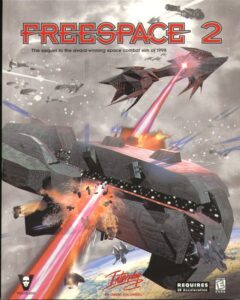

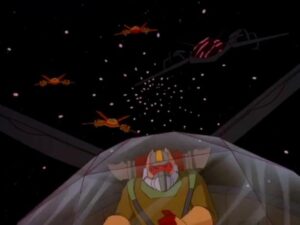


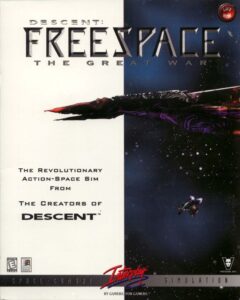
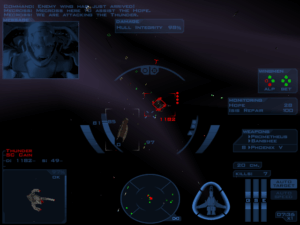
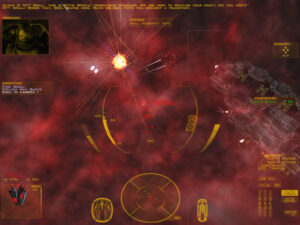




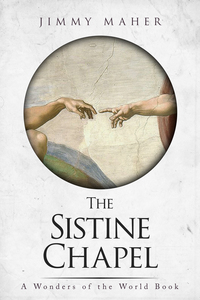







lee
November 7, 2025 at 5:47 pm
Oh hey, that’s me!
thanks for the shout-out and the legend-building, Jimmy <3
Zack
November 7, 2025 at 6:28 pm
Do you yourself not consider the likes of Elite Dangerous and Star Citizen (in whatever state it may be), or Eve Online (sort of, I guess ?) to be Space Sims that carried the torch ? Or do you only say to speak about near the time period the blog is looking at ?
Jason Dyer
November 7, 2025 at 6:55 pm
I could see the “narrative-driven” part excluding all of those, but I’m confused how that works with the X series (which started in 1999, and still has expansions being released to this day). All of them are on Steam.
Zack
November 7, 2025 at 7:27 pm
You’re right, I forgot X. Definitely fits the bill of Space Sims with a bit of narration. Elite Dangerous does kinda have a story though, it’s more of a meta, big scale one however.
Jimmy Maher
November 7, 2025 at 7:55 pm
Those games and others similar to them were usually released by smaller and/or less prestigious publishers, with limited promotion, limited development budgets, and little expectation that they would even cross the average gamer’s radar. Niche products, in others words, such as adventure games also became by the turn of the millennium. This article is about the end of the space sim as a marquee genre. The true end of that line would be Starlancer and Freelancer, which were published by Microsoft in 2000 and 2003 respectively. But more on them next time. ;)
Martin
November 12, 2025 at 12:14 pm
I was about to ask about those two right away, but our sly author has it covered already :D Looking forward to it.
Darker
November 7, 2025 at 6:42 pm
I am pretty sure Mark Hamill is still present in Wing Commander Prophecy, just no longer as main character.
Jimmy Maher
November 7, 2025 at 7:57 pm
I believe this was little more than a cameo appearance. I had kind of assumed it was cobbled together from footage shot earlier, although I could be wrong.
Alex Smith
November 7, 2025 at 10:07 pm
That is definitely not the case. His role was small, but still integral to the plot and spread across multiple (though still relatively few) scenes. He interacts with other characters in the game, including the protagonist. This could not have been accomplished with reused footage.
Jeff Sampson
November 7, 2025 at 10:14 pm
New footage, complete with a heroic sacrifice / ambiguous fate. https://www.youtube.com/watch?v=Fy61yLCpaV0
Tom Wilson and Ginger Lynn Allen also return, and the main character, the fresh young pilot, is played by a guy I also saw in a pizza commercial. Speaking of pizza, the cheese is indeed off the charts in Prophecy. There was also a downloadable expansion in the age of dial-up, I think it might have been released for free by EA as a PR move during the Ultima Online lawsuit.
Needless to say, there was no FMV in the expansion, the plot unfolds through text and epistolary email. Ridiculous padding as far as gameplay goes, later bundled with the main game, natch. For Wing Commander die hards only, before they track down an Xbox account that bought Wing Commander Arena before it disappeared.
Busca
November 7, 2025 at 10:35 pm
There is a video here on the Wing Commander CIC site showing Mark Hamill appearing on the Daily Show in December 1997 and talking, among other things, about Wing Commander Prophecy.
Sounds to me like it was not just reusing existing footage of him, but judge for yourselves.
The Wargaming Scribe
November 7, 2025 at 7:50 pm
Wargames may be my favourite genre, but Freespace 2 is in my personal top-3 of best games of all times. Lee mentioned a lot of good reasons, but I believe there is another one: Freespace 1 and Freespace 2 managed to make you feel one cog in a large military machine (rather than the hero of the day like Wing Commander or the the X-Wing games did) – but if this cog fails the whole battle may be lost (eg because your mission is to escort the bombers that will neutralize a cruiser, and if the bombers are shot down then the cruiser will shot at your own cruiser and destroy it, and THAT cruiser is supposed to be fighting other capital ships and make the difference).
Ralph Unger
November 7, 2025 at 8:03 pm
I think you are talking about drag rather than inertia at the top of the story. Airplane dynamics, with the air drag slowing the aircraft, instead of arcade asteroids type dynamics, where you will fly across the screen until you 180 and thrust against your direction of travel.
Sniffnoy
November 8, 2025 at 12:01 am
Yeah, “inertia” is definitely the wrong word here, I was going to point that out. “Inertia” by itself would mean you don’t slow down over time — the opposite of what’s written!
Jimmy Maher
November 8, 2025 at 8:06 am
Right you are. Thanks!
Play History
November 7, 2025 at 8:31 pm
I think the reasoning that the genre fell apart purely because people didn’t want to read the manuals is a little reductive. I did my own examination on my blog about the fall of flight sims generally, and on top of those reasons I think narrowly focusing on the PC experience doesn’t quite tell the story.
While something like X-Wing Alliance is decently impressive, is it really moreso an examination of the Star Wars fantasy than Shadows of the Empire, the slightly later Rogue Squadron, or even X-Wing from years earlier? Franchise-locked subgenres have an issue of pushing beyond these types of limitations. Plus, the technology of games on console was just a lot easier to get working. It’s more about how the way people paly games fit into existing habits.
I will be needing to invest in a flight stick soon in order to do some proper research on Looking Glass – if anybody has any modern suggestions.
Mike
November 8, 2025 at 11:20 pm
The thing about the fall of the genre in the late 1990s… you could play X-Wing, TIE Fighter and at least the early Wing Commanders with a keyboard just fine (same as the original Microprose F1 GP). I know, since I did. It was clunkier than a joystick, sure, but you could learn the controls well enough to play against a computer – since the game was tuned to allow that.
But playing a multiplayer-oriented space sim with a keyboard? No way was I going to even try – I knew I was a filthy casual player, and had little interest in a “real” simulator setup.
Captain Kal
November 9, 2025 at 8:39 pm
My recommendations:
1. Logitech Extreme 3D Pro Joystick
(https://www.logitechg.com/en-eu/shop/p/extreme-3d-pro-joystick)
2. Turtle Beach Velocity One Flight stick
(https://eu.turtlebeach.com/products/velocity-one-flight-stick)
or a used Microsoft Force Feedback 2!! ( I bought a working one from a friend of mine recently, and I am having a blast !!!!!!!!) Best ever!!!
Some Mods by the way:
X-Wing Alliance Upgrade
(https://www.xwaupgrade.com/)
TIE Fighter Total Conversion
(https://sites.google.com/view/tie-fighter-total-conversion)
XWVM – X-Wing Virtual Machine
(https://www.moddb.com/mods/xwvm)
Finally, there is a technical demo of Babylon 5 – Into The Fire somewhere. But I had to create a Win 98 VM with pcem to try it!!
fform
November 10, 2025 at 12:19 am
Thrustmaster T-Flight Stick X is a reasonable modern choice, although I grew up playing these games with a Microsoft Sidewinder 3D Pro and find the lack of left/right twist control (allowing you to pivot without rotating, like firing a jet on the side of the ship) to be frustrating. I would recommend avoiding a full HOTAS setup because space sims require keyboard shortcuts and you’ll probably want space on your desk to stabilize the joystick. Besides which, there would never be enough shortcut keys on a joystick/HOTAS setup alone for something like Freespace.
Vince
November 17, 2025 at 10:13 am
I wonder if people (as in the majority of the audience) simply just got bored of the genre as it fundamentally didn’t really progress much in terms of overall structure since Wing Commander 2.
Even while not being a sim guy, I loved the original X-Wing, which was my first space sim, and later on played Wing Commander 1/2 and Tie Fighter to completion.
A few years later, I bought X-Wing Alliance boxed on release (an occurrence reserved only for games I was really looking forward to while I was a student), but I remember getting bored halfway and never finishing it, which was also a quite rare occurrance for me.
I look forward to try Freespace 2 when I get the itch, but even from the very complimentary descriptions it sounds like an extremely polished iteration of the original concept. I can see some parallels with Starcraft 2, which could be considered in some ways the peak of the RTS genre and also its death knell.
Ishkur
November 7, 2025 at 8:57 pm
So what’s the latest word on Star Citizen, anyway?
John
November 8, 2025 at 3:00 pm
As I recall, there’ve been some indications in the last couple of years that something, possibly just the Squadron 42 single-player game, might get released in the next couple of years but the history of Star Citizen is such that I don’t really believe it.
Jeff Sampson
November 7, 2025 at 9:14 pm
Mark Hamil was in Prophecy, just not the main character. I think they compensated with less sets, it was like the first game almost: the bar and the briefing room, plus miscellaneous.
Alex Smith
November 7, 2025 at 9:49 pm
“Less positively, the movie sequences were cheesier than ever, populated by community-theater-grade acting talent — the likes of Mark Hamill and Malcolm McDowell were well out of reach of this shrunken budget”
I know another commentor also mentioned that Mark Hamill did appear in this game, but the issue here goes beyond that, as I would not consider this statement a fair characterization of the acting talent in the game.
Tom Wilson also returns for this one, and most of the other major characters are played by “real” actors as well, just as in the prior games. The main character is played by a young actor named Steven Petrarca, who had guest roles on several network TV shows and was a regular cast member in one show that lasted for two seasons. Chris Mulkey returns from WCIV, who was at the time and is still today an incredibly busy working actor doing guest shots here and there. Peter Jason, another returning actor from WCIV, has over 250 credits to his name. Most of the other actors have also enjoyed protracted stints working in Hollywood, albeit mostly in TV series guest spot roles.
Now, I am not claiming the movie side of Prophecy is particularly good, nor am I claiming that anyone of the stature of John Rhys-Davies or Malcolm McDowell was involved in this thing, but basically every role was filled by working actors who at the very least had a slew of TV guest spots to their name. This is something that always set the WC interactive movies apart from other entries in the genre: they did use real actors in every role rather than a bunch of local unknowns with maybe one serious actor to headline. I don’t think it’s fair to characterize this assortment of steadily working actors as community-theatre level talents, which conjures up images of the 7th Guest or Phantasmagoria and their even worse cheesy acting provided by actual local theater types.
Jimmy Maher
November 8, 2025 at 8:11 am
Fair enough. Thanks, everyone!
Busca
November 7, 2025 at 11:01 pm
Looking beyond computer games and into the console space I’ll also mention Colony Wars by Psygnosis for the PS1 (1997) here. It was quite well received and sold enough to produce two sequels in 1998 and 2000.
While I have so far only played (partly through) the first game, it seems fun enough to me and has branching plot lines leading to a lot of different scenarios and potential combinations.
Apparently they took a page from the LucasArts playbook: after fighting for the ‘League of Free Worlds’, in the second game you switch sides to the ‘Colonial Navy’ of the ‘Earth Empire’. In the third game you are neither and instead a mercenary.
While being much less known than the games covered in Jimmy’s article, it did and still does have its fans as you can see e.g. in this 2014 Eurogamer article, another one on gamerevolution from 2018 or this thread on the space sim games reddit.
Darker
November 8, 2025 at 10:33 am
Since we are in the territory of forgotten classics, I’ll mention my personal favorite – Darklight Conflict from 1997. A bit arcade-y, but it has a few interesting mechanics that differentiate it from other games in the genre. In addition, it has probably the best lighting effects and explosions out of all space sims of that era, all without using hardware acceleration.
Mike Russo
November 8, 2025 at 2:04 am
This is a genre I’ve never jumped into with both feet (I did play the Wing Commanders all the way through Prophecy, and Tie Fighter, but that’s about it), so it’s interesting to read this overview of how its years as a platform for blockbusters wrapped up. I’m a little sad there’s no mention of Privateer 2 – I’m mildly curious albeit the thinking behind it, given that it shed the Wing Commanders branding between the first installment and the sequel, and the marriage of FMV with a more open-ended gameplay structure was an interesting though IIRC not especially successful combination (getting a pre-fame Clive Owen to star did work out well, though!)
Oh, and I agree with others that that bits about inertia are confusing, not least because the later Independence War games, which came out in the era when space sims were firmly in the niche-for-the-hardcore camp, made a more realistic implementation of inertial space flight their calling card.
Gordon Cameron
November 10, 2025 at 3:54 am
The first Independence War actually came out in 1998, predating Descent: Freespace.
It was named Space Sim of the Year by CGW in early 1999.
Feldspar
November 8, 2025 at 4:29 am
Hate to be the resident nitpicker, but the mines in the Descent games aren’t located on asteroids (mostly), but underneath the surface of different planets and moons in the solar system. With the first game’s campaign being a tour of the solar system and the second one moving to alien worlds.
Also should be “Christopher Franke” (no M)
Jimmy Maher
November 8, 2025 at 8:17 am
Thanks!
Mateus Fedozzi
November 8, 2025 at 11:17 am
Nothing to say about Starlancer and Freelancer? I remember the gaming press writing quite a bit about them back in those times.
John
November 8, 2025 at 2:28 pm
Freelancer is arguably a cult classic, but it’s an open-world game like Elite or Privateer rather than a mission-based game like Wing Commander, TIE Fighter, or Freespace. It’s also worth noting that Freelancer isn’t a proper space sim. It’s meant to be played with a mouse and a behind-the-ship perspective whereas all the other games I’ve mentioned were meant to be played with a stick and an in-the-cockpit perspective.
Starlancer, I’m afraid, came and went without leaving much of an impression on anyone. I’m not sure how many people even played it. I think it suffered a lot for being a game from the same studio as the much more ambitious and much anticipated Freelancer.
John
November 8, 2025 at 2:47 pm
Ah, Freespace. I finally sat myself down and made myself finish Freespace recently. Well, I say finish, but the truth is that the game glitched out on me in the third to last mission and I’d been having such a miserable time with it that I took that as a sign that I should just quit. Looking back, I can see why people like Freespace, but personally I found it pretty rough. The game is not always good at communicating its intentions to the player and the mission scripting is frequently more heavy-handed than I’d like. There is one mission about a third of the way in that requires the player to do something that as far as I can tell is covered neither in the manual nor in the tutorial missions. The real problem, I think, is that Freespace is a space sim that assumes you’re familiar with the conventions of space sims and that you’ve played a lot of space sims recently. While the former is true for me, the latter was very much not. I have always wanted to play Freespace 2, since I’ve been hearing for decades how good it is, but Freespace 1 has left me somewhat uncertain. Freespace Open and the Knossos mod manager are still installed on my PC but I no longer know when or if I’ll get to Freespace 2.
xxx
November 11, 2025 at 8:34 pm
And don’t forget X-Com: Interceptor, a baffling attempt to make a space combat game out of the ailing X-Com franchise. Came out in 1998, just in time for the genre to be dying out, and is remembered by basically nobody but die-hard X-Com fans at this point.
Still, I don’t think it’s fair to say that the space sim genre is dead. What about Star Citizen?
(Crickets chirp. In the silence, someone nervously coughs.)
…I’ll see myself out.
Bob Rooney
November 12, 2025 at 11:05 am
Then there’s Renegade: Battle for Jacob’s Star, a game from a very niche franchise for a dying niche market and is basically remembered by me and some other dude. Hi, Bob.
Michael
November 12, 2025 at 11:17 pm
“for everyone to cotton onto that fact.”
I was wondering if this colloquialism would raise any questions among your non-American readers. Apparently not.
To me “cotton to” is the “correct” or “correct-sounding” way to say it, though Google N-Gram assures me that “cotton on” is only a bit less popular. Note that this could be cluttered with results that have a different intent, like if someone wrote “They loaded the cotton on the truck.” “Cotton onto” seems to be vanishingly rare, and possibly “incorrect English.” Up to you to judge, of course, if I’m being helpful or not here.
Jimmy Maher
November 13, 2025 at 10:48 am
“Cotton onto” — or “cotton on to” — is actually more typically British usage, but I like it better than “cotton on” to “cotton to” alone. (I’ve picked up a lot of Britishisms, as readers have probably noticed. Presumably it’s a byproduct of some combination of discovering the Beatles and becoming an Anglophile at age ten, studying English literature at university, and not living in the United States for many years now…)
Squireoivanhoe
November 14, 2025 at 2:06 am
Oh man, if I had known about Freespace as a preteen I would have gone nuts over this. Thanks Jimmy, it’s going on the list.
My favorite space sim from this period is a game called Tachyon: the Fringe. Featuring a relentlessly entertaining performance from the king of B movies, Bruce Campbell, it also was more of a mercenary for hire game that surprisingly had a good deal to say about unchecked corporate power, the ethics of violent resistance, and the future of space colonization. You play as a mercenary, and about a quarter of the way through there is a fun twist that has you choosing contracts from several less than reputable sources. Eventually, you have to choose whether to side with the big corporation or the local “terrorists”, and the two have enough differences between their storyline, weapons, and their ships to make a subsequent replay drastically different.
And the gameplay is so much fun. Nothing beats lowering their shields with your lasers then pressing the top button of your joystick obliterate a dodgy foe with your railgun. I love it so much.
Jeff Sampson
November 15, 2025 at 11:31 am
The Phantom Menace premiered on May 19, 1999, not in June. And the second trailer did run before the Wing Commander movie, although it apparently could also be viewed online in low res Quick Time.
Also of note is Earth & Beyond, a space exploration MMO from 2002 to 2004 with ship combat, it was Westwood’s last game before EA shut them down. The Privateer MMO was cancelled supposedly because it was a competing project. Privateer 3 was also cancelled in 98, just after getting a big magazine preview, a death knell like the Babylon 5 game cancellation. Freelancer is essentially Privateer 3, it and the two Privateer games give a snapshot of three eras: the 2.5d era, the FMV era, and the early 3d era.
There’s also an interesting claim on Wing Commander sales figures from the back of a tie-in book for the movie, The Confederation Handbook(https://archive.org/details/wingcommandercon0000unse): “With the help of such international stars as Freddie Prinze, Jr. (I Know What You Did Last Summer), Matthew Lillard (Scream), and Saffron Burrows (Circle of Friends), the hit film WING COMMANDER has brought the five-million-copy bestselling series of games to big-screen life.” The “hit film” claim was premature, but five million sounds plausible if you include spin-offs and ports. I actually own a copy of that book, it’s for those who love the movie so much they want to see a cross section of the Tiger’s Claw and character bios, to go along with teen gossip mag articles about Freddie Prinze, Jr. and Matthew Lillard.
The Wing Commander movie may have had the shortest turn around of Chris Roberts’s career(in an anniversary issue, CGW listed Strike Commander as one of the most infamous vaporware games. If they only knew…). I’ve gotten the impression he was in over his head, movie production is more complicated than people assume, from what I gather a first time filmmaker isn’t just handed fifty million and told “Come back in a year with something great”, which would be comparable to the amount of latitude his team had for Wing Commander IV.
Star Lancer on the other hand is actually a fun throw back to the first Wing Commander, while adding a little more X-Wing like complexity. It was a sci-fi sim stablemate to MechWarrior 4: Vengeance, also published by Microsoft in 2000, with the same Microsoft splash screen. MechWarrior 4 got two expansions, the last of which was MechWarrrior 4: Mercenaries, not to be confused with MechWarrior 2: Mercenaries, or MechWarrior 5: Mercenaries. The tank-like controls for MechWarrior made a mouse more viable(Freelancer tried to get with the times by being geared for mouse use), but sales might have been weak enough to have been another nail in the coffin for space sims, along with Infogrames’s Independence War 2 not doing too well in 2002.
As others noted, Independence War modeled inertia in space more accurately, and let you spin independent of your direction of travel. The Wing Commander games also let you do a sideways slide where aircraft-like flight was temporarily suspended, which was incredibly counter-intuitive but fun.
Jimmy Maher
November 15, 2025 at 4:28 pm
Thanks!
John Doe
November 20, 2025 at 3:13 pm
It is always a special feeling to see one of my childhood games receive the ultimate accolade in the form of people pouring uncountable hours of their time into recreating the engine to get them running on modern machines. Diablo and TES: Morrowind are examples of this.
Warzone 2100 and Freespace 2 are even more special, because the creators of the work of art handed it over to the new custodians with a bow.
BB Durall
December 9, 2025 at 5:51 pm
“Keeping with the golf theme, the low-rent Caddyshack ripoff Who’s Your Caddy?, which made Wing Commander look like Hamlet, was released in 2007 and failed to earn back its $7 million budget. It’s best remembered today for an anecdotal report that Bill Clinton loved it.”
Couldn’t help but think of this quote when I read this article today: https://people.com/george-clooney-reveals-his-wildest-prank-involves-bill-clinton-11861153
Nye
December 15, 2025 at 7:24 pm
I wish for a formal resolution to the plot to this day. The final impression of total futility, total chaos, despite every tactical victory was far too deeply felt.
Despite not playing it in over 20 years I can still recall every detail, every vessel; name, strength and weakness etc. plus most of the soundtrack and dialogue. I don’t think any other game has made such a lasting impression on me.
Honestly was a narrative work of art.